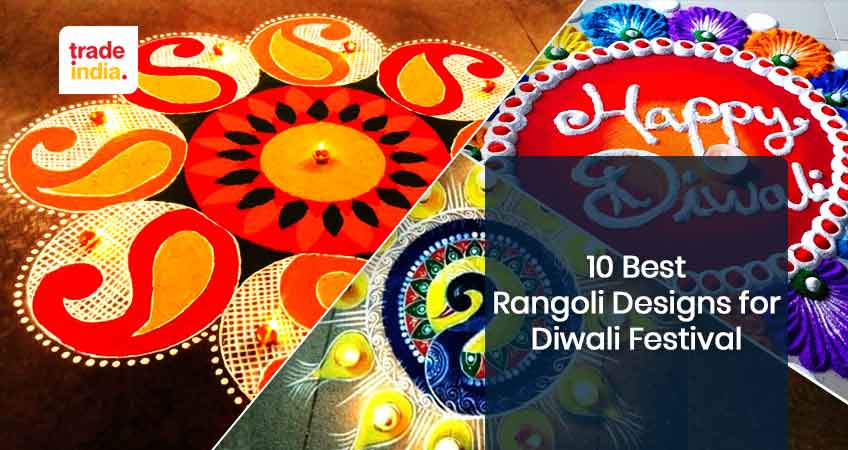10 Best Rangoli Designs for Diwali Festival

This festival of lights known as Diwali celebrates the triumph of good over evil. We clean the homes and beautify them with lighting, diyas, nice furniture, flower, and rangolis to commemorate the occasion. Bright rangolis give your home a stylish touch. We typically create rangolis at the entryway to our homes to welcome Goddess Laxmi, the goddess of wealth and keep evil or any other types of negativities out.
A century-old tradition is to create rangolis for your home's door. Colours, paints, beans, rice flour, crushed limestone, and even chalk can be used to make rangolis. Making a Diwali rangoli is no longer a difficult chore thanks to the availability of gorgeous and distinctive rangoli toolboxes in stores and online. Make a stencil of your preferred rangoli to order, then simply fill in the blank spaces with colour by laying the stencil just on the ground.
Let’s look into some of the popular and new Diwali rangoli designs that you can make yourself for your home:
Diya Rangoli
Given that a Diya serves as the centrepiece of this Diwali rangoli, it can be created during Diwali. Draw the Diya first, then the outside flowers and foliage. Fill up the colours oppositely. The colours pink, green, and yellow stand out in this design and add aesthetic appeal. After the centre has been filled in with green, add the contrast by writing "Happy Diwali" in white. Since it doesn't entail creating freehand designs, the rangoli design that has recently gained popularity requires relatively little hand-turning expertise.
It is based on placing big dots in the necessary model first, then using your fingertips to move the chalk powder in some kind of a specific way to create the pattern. Plot the coloured dots beginning with the Diya, taking into account the quantity and layout of the flowers. For the flowers, spread the colour with your fingertips. A stick can be used to create the leaf design. This upcoming Diwali, impress your guests with this straightforward but vibrant rangoli.
Square Rangoli
A lovely brilliantly coloured floral arrangement has been painted on a checkerboard four-square background in this simple yet elegant traditional artwork. The yang and yin of life are represented by the colours' alternate arrangements. In this sophisticated layout, symmetry plays a significant role. The orange and red colours used in the Diya and flower motifs contrast effectively with the backdrop colours.
Mandala Rangoli
If you enjoy Mandala art, you must try this latest Diwali rangoli design! Chalk powder can be used to make an elegant yet basic pattern. First, similar circles are positioned equally apart from one another in the centre with more gaps coming in places wherein geometric patterns will come in place.
As seen, each of them is covered in various geometric patterns. An enormous flower with 9 petals appears around them. Each petal has further smaller circles in them consisting of geometric patterns drawn inside it in white. For a final touch, lamps are positioned in the corners. Further, an all-corners independent smaller circle can be put in place which can act as individual flowers. The complexity of this Diwali rangoli depends on how much of a pattern you want to put in place.
Kollam Rangoli
A Rangoli's primary function is to channel inner force through curves, lines, and vibrant colours. One such unique design for the prayer room is shown below. You can do that by hand-drawing a series of symmetrical circles. The intrinsic patterns produced in each round give the Mandara-style artwork a spiritual feel. Bright blossoms towards the pattern's conclusion hold your priceless lamps while also completing them.
Muggu Rangoli with Diya
Beginners can easily create this lovely yet simple Diwali rangoli design. It is a straightforward flower with a bent petal and mango motif drawn in the centre. The strong distinction between the colours utilised in this design is its best feature. The rangoli design is given an attractive touch by the gradation in the outer layers of the leaves and the checkerboard floral pattern.
It may be tailored to fit any festival and is appropriate. For Sankranthi during Diwali, you might personalise it with diyas and floral petals. Although this pattern appears challenging, after you master it, you will adore the comments that come your way.
Contemporary Rangoli
Take a look at this rendition of the traditional Diwali Rangoli that is modernised. The combination of hues and textures creates an unreal impression in the viewer's eyes. The Rangoli's fundamental design does not change. The external filling, however, is what adds attractiveness. Fingers are used to make wave patterns on top of thick layers of shaded colour powders. You may even experiment with different implements, such as spoons and ice cream sticks, to create your artwork.
Floral Rangoli
This Diwali rangoli design is bright and colourful with lots of flowers. To achieve appropriate symmetry, begin with the basic floral pattern in the centre and afterwards sketch the other flowers on the other five sides. Then use the checkerboard pattern to fill in the spaces between the flowers. Starting from the inside, fill in the colours. Due to the use of multiple contrasting colours in the blooms and the eye-catching diverse patterns in between, this design is quite appealing. It is appropriate for all momentous occasions, including weddings and family rituals. Make the rangoli at your front entrance to wow your guests the next time your family gathers at your house.
Peacock Rangoli
Decorate your house or place of business with these lovely peacock rangoli designs. India's national bird is the peacock, and in Indian culture, the spreading of its wings represents joy, happiness, and cheer. The peacock, also known as Mayura in Sanskrit, has a special place in many temple arts, poems, folk songs, and rituals. On celebrations like Diwali, Dusshera, New Year, and numerous other Indian festivities, peacock Rangoli is particularly popular.
Pookalam Rangoli
Here is a brand-new flower-petal-only Rangoli pattern for the Deepawali celebration. The Pookalam tradition from Kerala is carried over to Diwali as well. This Diwali rangoli design is so meticulously made that it increases the delight of the celebration, and the flowers are carefully chosen to complement the festive mood. The invention can be made even more glorious by placing Diyas in its focal point and other key locations.
Lakshmi Rangoli
This design is one of the latest Diwali rangoli designs in use nowadays. Use this customary design to celebrate the Goddess of Wealth during Diwali. The representation of 2 white elephants dumping heaps of money into the Kalasa represents Dhana Lakshmi entering your home. The Devi's residence is a Lotus, which serves as the basis for the entire sketch. To complement the occasion, the phrases "Shubh" and "Laabh," which indicate "Auspiciousness" and "Benefits," are inscribed on either side.
Rangoli patterns are thought to have originated many centuries ago. There are also a few references to rangoli patterns in our scriptures. Over many centuries, rangoli art has undergone numerous changes. In many regions of India, rangoli is known by different names. It is referred to as Kolam in Tamil Nadu, muggulu in Andhra Pradesh, muggitu in Karnataka, Mandana in Rajasthan, and so on.
Any Hindu home in India will welcome you with a rangoli design, which is typically created on the floor using chalk or limestone powder. Since rice flour can serve as a source of food for small insects and birds, it has traditionally been used to make rangoli designs. Nearly all types of Hindu religious celebrations, festivals, weddings, and other events use simple rangoli designs. Rangolis are thought to keep evil spirits away from dwellings. So, this Diwali tries out some new rangoli designs to match your home décor and celebrate the festival of light.
FAQs: Rangoli Designs
Q. What is the significance of rangoli on Diwali?
Ans. The rangoli is made to greet Laxmi, the goddess of riches and luck, and it symbolises the joy, optimism, and vibrancy of a home. A Hindu home without a tidy entry and rangoli is thought to be the home of evil (bad luck). Rangolis serve purposes that go beyond ornamentation.
Q. What are some simple Diwali Rangoli designs?
Ans. The Diya often referred to as Deep, Ganesha, Lakshmi, flowers, or birds of India are a few unique patterns for Diwali Rangoli. Hindu deity faces, geometric patterns, peacock themes, and rounded floral patterns are among the patterns. Several of these motifs have been passed down through the centuries and are traditional.
Q. What are the materials used in Diwali rangoli?
Ans. Some of the things that can be used for Rangoli are flower petals, raw lentils, rice, salt, chalk powder, and so on.
Q. How do I make different types of Rangoli?
Ans. For making different types of rangoli, you should have a clear idea of what you are making. 10 options are presented for you above which you can take as a reference. Other than that, since rangoli is something that can be experimented with, if you have a picture in mind, you can go for it.
